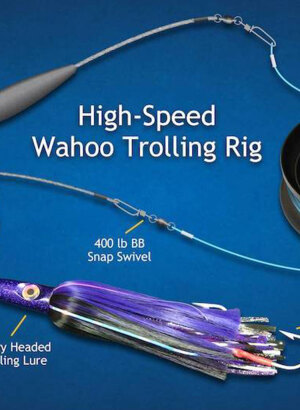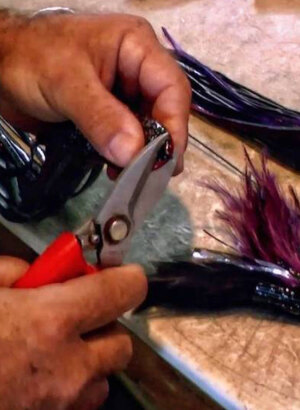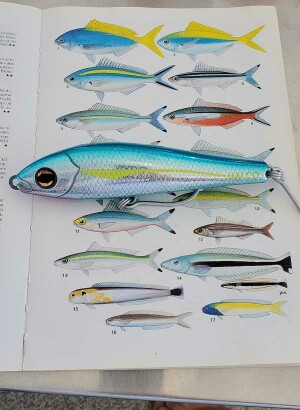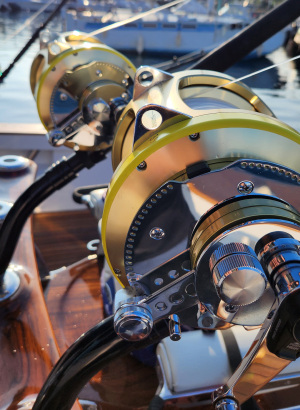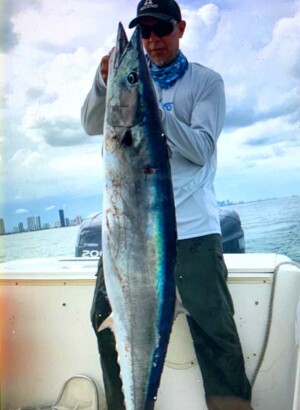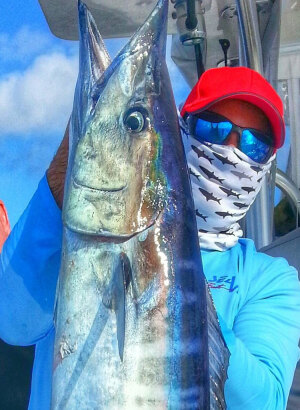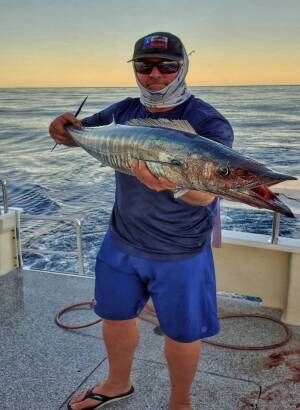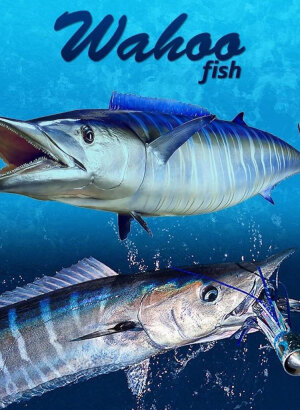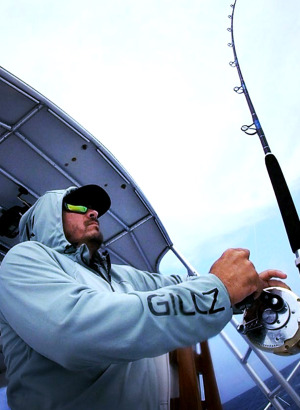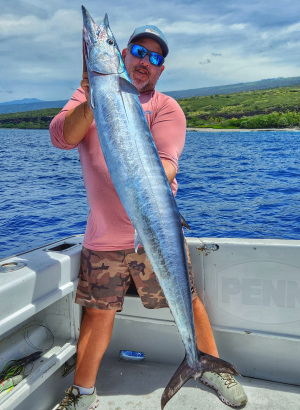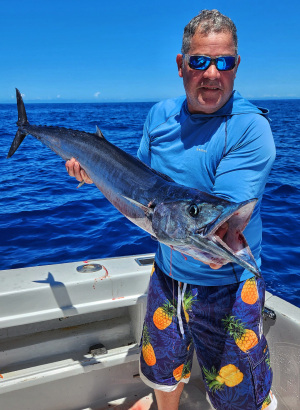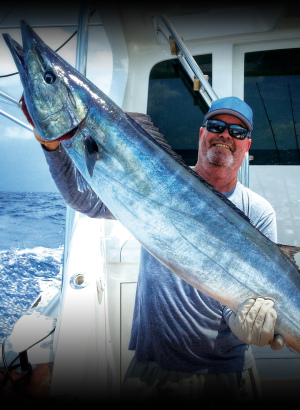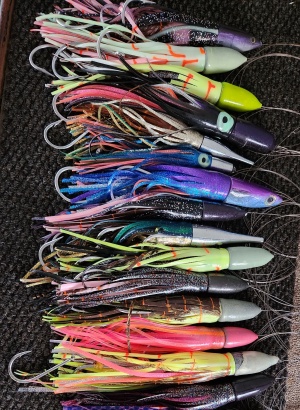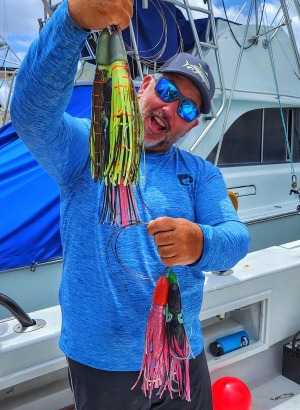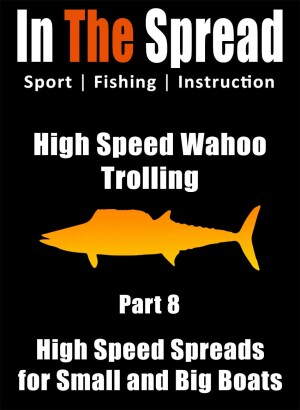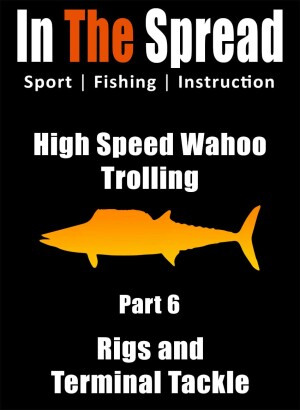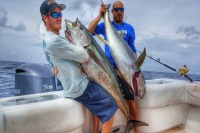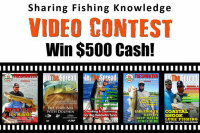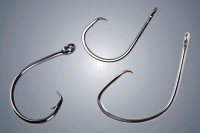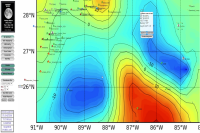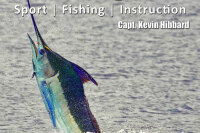Wahoo fishing is a popular method for targeting this fast pelagic predator. Factors to consider include location, fuel budget, and opportunities for catching other species. High speed trolling is more popular, while slow trolling is more deliberate and labor-intensive. Both methods use similar tackle, but the mechanics and technique vary.
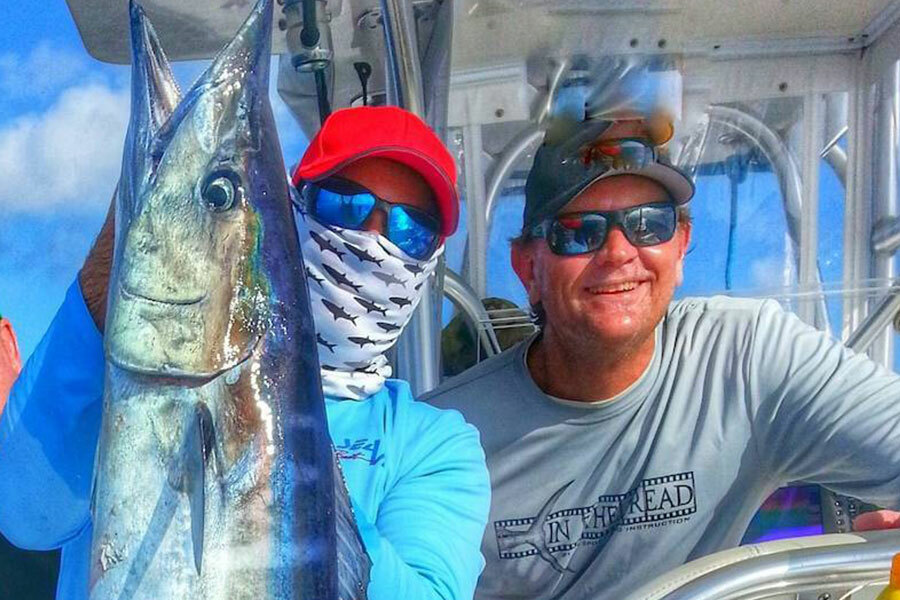
Slow Trolling Wahoo - A Lethal Tactic
Trolling for wahoo is perhaps the most popular method for targeting this lightening fast pelagic predator. If you are like me, you love to catch them and eat them, even more. If there was only one fish I could eat for the rest of my life, wahoo would be in the top 2, along with mangrove snapper. So, when it comes to heading out for a day of wahoo fishing, points to consider are where you are fishing, fuel budget and opportunities for catching other species. Some fishermen like the fast pace action of high speed trolling, while others prefer the more deliberate nature of slow trolling wahoo. It is all about preference and the style of fishing that brings you harmony.
When it's all said and done though, high speed trolling for wahoo seems to get the nod over slow trolling for wahoo. This may be because there is a lot more discussion and information out there about high speed trolling and a lot less about slow trolling. The interesting part is you end up using pretty much the same tackle for both. The big difference comes down to the mechanics of how each is executed. With high speed trolling, you get your spread set and run, waiting for a strike. With slow trolling for wahoo, you typically will have a planer of two in the water with down baits, as well as rigger baits and these baits must be checked somewhat frequently to ensure you still have a tasty morsel on the hook. Wahoo will cut you baits off and if you are pulling hooks without baits, you are out of the game. Slow trolling, in that regard, is a bit more labor intensive. You could debate that slow trolling is more technical, as well. Perhaps, that is why more fishermen don't do it. But, don't kid yourself. Slow trolling for wahoo is very productive when executed properly.
Bonus Video: Wahoo Fishing – Slow Trolling with Mike Dupree
Discover Capt. Mike Dupree's secrets for wahoo slow trolling. Take a deep dive into the art and science of capturing this elusive predator while optimizing your sport fishing experience, covering everything from bait preferences to outfit details. View Short Trailer Below or Learn More Here
Wahoo Behavior
Before we get into the discussion on the merits and tactics of slow trolling, let's take a look at wahoo behavior. Not considered to be a schooling fish, but rather are characterized as being solitary fish that forms in packs like minded predators. The reason they will be found in loose aggregations is their affinity for structure, all kinds of structure where there is good water movement. The combination of current and structure creates the building blocks of the oceanic food chain. That food, in the form of bait fish, are there because they are being forced onto the structure by current or they are there for protection or their own food. Being voracious feeders, wahoo will be where you find bait.
A primary driver of why wahoo are in certain places at different times throughout the year is water temperature. Wahoo do not have the ability to regulate their body temperature, so they will always be found in the more temperate waters of the tropics and subtropics. These are areas where the water temperature ranges from 65 to 80 degrees Fahrenheit, depending on where you are located. As the seasons change and with them the sea surface temperatures, wahoo will move. The bait fish are moving with these changing sea temperatures, also. Within just about every wahoo fishing destination, you will have resident fish and transient fish. The transients are migrating. Research indicates that bigger fish are more inclined to traverse the ocean following baitfish and spawning. So, back to the food part, wahoo will be moving the stay warm and eat. When SST rise or fall to much, the fish move. Expect the fish to move into cooler waters during warm summer months.
When it comes to the diet of wahoo, there is not a lot of discrimination going on. Any sea life that is within the strike zone when the bite is on will get smashed. By all accounts, the bite does need to be on or this apex predator may not budge. Tides play a big part in when wahoo feed. We will get into that in a bit. When it is time to gorge, you can bet that wahoo will feast on tunas, little tunny, flying fish, dolphin, jacks, herrings, pilchards, scads, and damn near any other schooling baitfish. Being blisteringly fast swimmers, everything is on the menu. They attack aggressively, slashing their prey's tail off, before circling back to finish it off.
Structure Fishing for Wahoo
All fish relate to structure. They do this for protection, for food or both. This is fundamental. The type of structure fish are drawn to varies wildly. I say this because physical bottom formations, reef edges, oil platforms, wrecks, floating grass or debris and oceanic currents colliding together all form structure that attracts life and thus wahoo. There is one common reason wahoo are so structure-oriented and that is food. Hard surfaces in the water grow algae, which attracts small crustaceans, which are a food source for baitfish and on up the food chain. Current pushes plankton and baitfish which in turn entices other bigger species. If you can correlate current rips, temperature breaks and color changes with structure, there is a good chance wahoo will be on the scene.
When looking for color changes or temperature breaks, it is useful to use SST satellite imagery to reveal these surface temperature breaks and circulation features. This will help eliminate a lot of searching and unnecessary fuel consumption. If you can zero in on the areas that you feel will be most productive, you can set your course for those areas and save a lot of both fuel and time. Several top wahoo fishermen in the Carolinas note that more wahoo are caught in areas where the temperature break is subtle. For instance, a subtle edge will be one where 74 degree water is next to 76 degree water and a hard edge will be one where 72 degree water meets 80 degree water.
Even though most wahoo fishermen I know will say that most of their catches come in water 150-300 feet, it is not uncommon to be in waters well beyond 1,000 feet deep and find floating debris and weed lines loaded with bait, schoolie dolphin and other life. Lurking below will be packs of wahoo. Keep in mind, wahoo are not warm blooded, so in the open ocean, they will be near the surface, at least within a couple hundred feet. It comes down to food, water movement and ideal water temperature. Put those pieces together and more than likely you will find wahoo.
Weather, Tides and Currents for Wahoo
Weather plays a significant roll in how fish feed. The key is to look for periods of stability. A swinging barometer reflects changing weather patterns and that is a hard calculus to play with. If you can get out ahead of a frontal system, you will usually experience good fishing, but we can't all fish on those specific days. You sure as heck don't want to fish after the front. Instead, looking for periods where the barometer is steady will proof fruitful.
One thing is for sure and that is moving water drives the bite, either the incoming or outgoing tide. Wahoo may not bite on both the incoming and outgoing, but they will bite on one of them. Even offshore, as I mentioned, the times of day when the tides are changing correlate with the position of the moon and feeding times. You will find fish feeding times will fall around the major and minor times. It is a good idea to really pay attention to these peak periods and track whether you are catching wahoo, bigger wahoo or just more wahoo in general. Even well offshore, where tides may seem insignificant, the transition period of tidal movements trigger a wahoo bite, so it pays to know when such periods will occur. Tides are especially crucial when fishing for wahoo close to shore.
Slow Trolling Wahoo
Slow trolling for wahoo doesn't get near to attention that high speed trolling gets and that's probably because of the widespread use of faster trolling in tournament fishing. With so many tournament anglers high speed trolling and catching big wahoo, combined with all the related coverage in sport fishing magazines, more fishermen hear about about and have been able to learn the technique. Due to so many fishermen now high speed trolling, slow trolling just hasn't gotten the exposure it deserves.
You may ask yourself, what is the difference in the two styles of trolling. Speed of course. High-speed trolling speeds range from 14 to 20 knots and slow trolling 6 to 10 knots. You just cannot pull skirted dead baits much faster and if you are fishing planers, you really cannot go very fast. A slow and consistent troll is needed to take advantage of the scent and natural swimming action of the fresh baitfish.
The attributes and benefits of slow trolling for wahoo are many, the least of not which is the cost savings on fuel and that can be significant, in comparison to high-speed. You are likely to also catch more fish throughout the day. They may not be the monster you catch racing around in a fast boat, but they will be plenty. You also benefit from the occasional by-catch that will take your baits, like blackfin tuna, yellowfin tuna, dolphin and even billfish. Your boat and tackle will suffer less wear and tear.
Wahoo Gear
As far as the gear goes that you will use for slow trolling, it does not differ greatly from that which is used in high speed trolling. You will need a combination of 50 wides and 80 wides. The most important factor for either types of trolling is to make sure your reels have damn good drag systems. The one aspect of slow trolling to pay attention to is when using planers, you will need to use 80's. The combination of current and the action of the planer will put extreme heat on your reel.
A typical slow trolling spread may include 1-2 planer rods, a flat line if you are only pulling one planer, 2 short rigger rods and 2 long rigger rods. A shotgun lure is often times run way back. With the planer rods, No. 8 or No. 16 planers are common. The size of you planer is determined by the temperature. When it is hotter, the deeper you should fish, because the wahoo will suspend at greater depth. The deeper the fish, the bigger or heavier your planer. I suggest your planer to be run about 75 feet back. You want it to be running below the prop wash. The flat line should be set about 100 feet, the left short rigger 150 feet, the right short rigger 200 feet, the left long rigger 250 feet and the right long rigger 200 feet. These numbers are not set in stone and you should experiment with what works for your boat. A good rule of thumb is to try and get all your baits or lures in clean water, away from the prop wash. This will give the wahoo a clear channel to see and attack your presentations. Your shotgun lure can be back there 350 or more.
Wahoo Baits
Preferences on baits and lures vary by the fishermen. Common skirted baits include ballyhoo, mullet, mackerel, flying fish and strip baits rigged with either single or double hooks. Natural baits should be rigged to swim, a style that works perfectly at slower trolling speeds. A stinger rig can be incorporated to prevent cut offs, when the wahoo comes in and slices the back half of your bait off. Ballyhoo, mullet, mackerel, and belly strips are more in sync with slower trolling speeds than lures built to run at 10 to 15 mph. In addition, lighter, smaller baits and those rigged to swim work best at slower speeds, often as slow as 5 mph. Sea witches make outstanding skirting material for you wahoo baits.
When running rigged baits with wahoo, you will need to be hands on. It is highly recommended that you check your baits every 15 minutes or so. You can get cut off and not even know it and trolling a bait-less hook will never catch fish. There is no need to crank each bait all the way in. Just reel it in until you can see it swimming. If it is swimming well, drop it right back where it was. Your planer baits should be checked more often, as the action from the planer will easily mask a strike that cuts that bait in two. Be proactive with this and you will have more success.
Artificial lures are excellent to troll when bait is not handy. You can run lures from any position In The Spread. No pun intended. Swimming plugs with large lips like the Rapala X-rap Magnum is a solid choice. These lures cover the deeper section of the water column. The Yo-Zuri bonito and the Halco 220 Max both make lethal wahoo lures that will track very well. You can run lures anywhere, but a good shotgun lure is a great choice.
Boat Driving When Slow Trolling
When slow trolling, the art of navigating your boat becomes crucial, especially considering the varying underwater structures you might encounter. Each type of structure demands a different approach to maximize your fishing success.
- Reef Edges and Significant Bottom Structures (like Shelf Drop-offs): In these scenarios, a more linear, albeit meandering, course is effective. Imagine navigating along the edge of a reef, where you're following the contours but not in a straight line. Your path should mimic the natural shape of the reef or structure, allowing your lures to pass over different parts of the underwater landscape. This approach ensures that you're covering a broad area where fish might be congregating or feeding.
- Wrecks, Debris Fields, and Patch Reefs: These structures are more localized compared to the expansive nature of a reef edge. Here, a circular or large sweeping figure-eight pattern is more effective. The circular route allows you to consistently cover the area surrounding the structure, which is often where fish gather. The figure-eight pattern adds a bit of variety, letting you cover more ground and potentially encounter different groups of fish.
Regardless of the structure, the key is to maintain a consistent, slow speed. This ensures that your lures are presented in the most natural way possible, mimicking the movements of live bait. Speed and course adjustments might be necessary depending on the current, wind, and the behavior of the fish on a particular day.
Remember, the goal of slow trolling is not just to cover ground but to do so in a manner that increases your chances of attracting and catching fish. Your boat's movement should be deliberate and thoughtful, taking into consideration the underwater topography and the habits of the species you're targeting.
Hook Up
Upon hook-up, maintain the same trolling speed, do not slow down, this helps to drive the hook and entice additional hookups. You can also jerk on the lines that did get bites a few times, you can trigger additional bites. Avoiding slack is critical. Make sure not to start cranking or bump up the drag on the reel with the fish until the initial run dissipates. The driver should slowly turn the boat in the direction of the fish and maintain a 45 degree angle to the fish. You of course do not want to drive into shallower water, so be aware of your depth. Clear the lines shorter than the hooked fish on the side of the boat with the fish. Leave the other side out. If you get a wahoo on the shotgun, you may want to clear all the lines.
I hope this feeds your interest for slow trolling wahoo. The only way we improve upon our fishing skills is to consume information and apply the tactics and techniques that we learn. Fishing smarter means catch more wahoo. If you want to know more about wahoo fishing in general, check out our Wahoo Fishing Videos.
User Reviews



